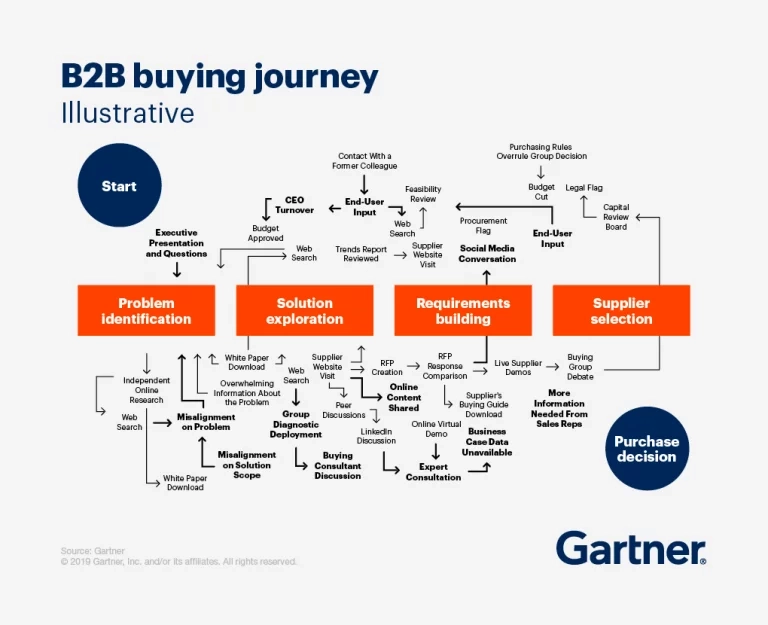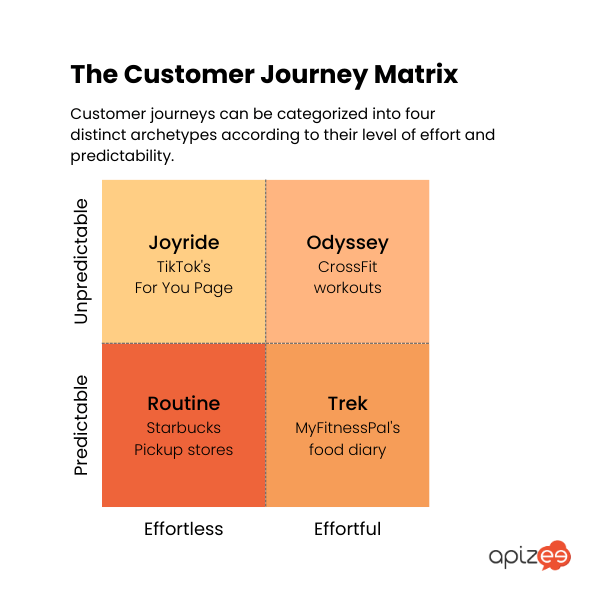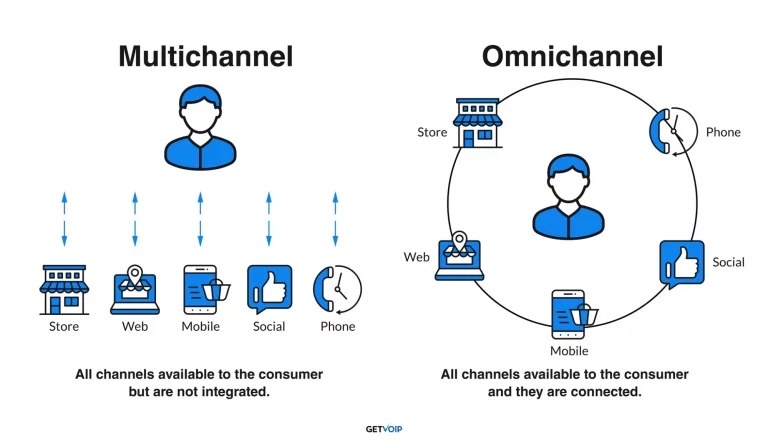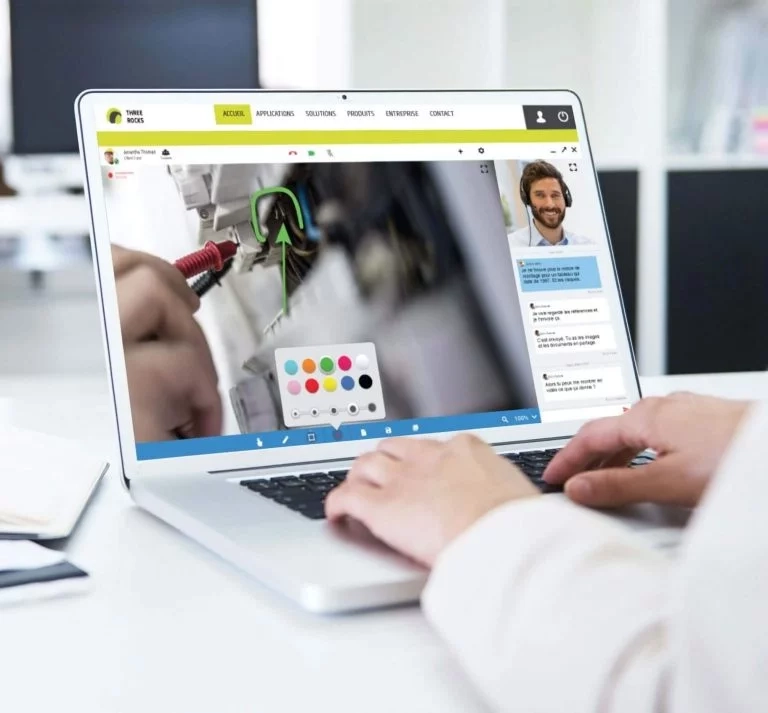Benefits and Best Practices for an Omnichannel
Contact Center



Running a customer support team is getting harder and harder to manage (or, at least, manage well). That’s because people are contacting your center from a variety of platforms.
Whether it’s email, phone, chat support, or some other device, your team needs to be reachable. A failure to do so means missing out on countless customers.
If this isn’t a priority yet, now is the time. An omnichannel contact center is your best option for bringing your support up to speed.
Throughout this article, we’ll explore what an omnichannel contact center is (compared to multichannel), how it benefits customer service, and three simple tips for getting started.
An omnichannel contact center offers multiple, unified channels to provide a seamless customer experience, no matter how customers contact you.
For example, a customer might contact your support team via live chat about an issue. Due to their unique problem, the conversation is passed over to video so the rep can see the problem in real time and offer solutions.
This process should be as simple as possible, and the quality of care should be consistent, even if the customer is dealing with different representatives.
Why is omnichannel customer service critical now?
88% of customers state that a company’s customer service is just as important as the products and services that it sells. In order to meet this crucial demand, businesses need to offer exceptional customer service on each of their channels at all times.
Furthermore, according to Gartner research, the customer journey is no longer linear. This is especially true in the B2B industry.
Instead, customers often loop around buying decisions several times before making a purchase. And they’re using a lot of channels to do so.

Source: Gartner
Whether it’s a web page, LinkedIn discussion, white paper download, or virtual demo, potential customers can take a lot of time to consider purchase decisions. Providing multiple communication channels for them to reach you at each step of the way is key.
B2C customer journeys can sometimes be more linear, but they’re still likely to use multiple devices across that journey.
We recently chatted with customer journey researcher Anton Siebert about what many companies are getting wrong in their customer journeys.
He talks about:
“There’s more to journeys than just a routine; there’s more than just convenience. There is an array of journeys that customers are happy to continue… so if you take that away, then you’ll diminish the value that you can offer to customers.” — Siebert
Learn more about what he has to say in our recent webinar.

Keep in mind that throughout this article we’re talking about a contact center rather than a call center. A call center (as the name would suggest) focuses on phone calls as the primary customer interaction. A contact center offers a number of different methods of communication, giving it the ability to become omnichannel.
Both omnichannel and multichannel contact center solutions offer a number of different communication methods for customers to get in touch with a company. The key distinction is integration (or lack thereof).
A multichannel contact center does not provide a streamlined handoff between channels. You can see the difference depicted in the image below.

Source: GetVoIP
For instance, a customer gets in touch with a company through live chat. They tell the agent about their issue, but the problem is too in-depth to be handled by this department, and they need to be transferred.
The customer now has to wait for a callback from a representative on another team. The representative gets in touch, but the customer has to explain the intricacies of the issue all over again.
An omnichannel approach opens up the organization so that both customers and information can flow between channels. Handoffs between social media messaging, chat, phone, and video can happen immediately, and anyone involved in the service has an up-to-date record of what’s happened so far.
Companies are often drawn to omnichannel customer service options because they want to improve their resolution time and create a better customer experience.
In addition to these selling points, there are even more benefits that an omnichannel strategy can bring your business.
Omnichannel customer service is no longer just a compelling or distinctive feature. It’s now a must-have for customer service teams, and 76% of customers report expecting these options.
By implementing the right software and training your employees to use them properly, your customer service providers can create a personalized experience for each of your customers.
For example, your sales team can input contact notes into your CRM discussing each customer’s unique needs. Then, when a customer reaches out about an issue, the representative already has a clear understanding of what they’re trying to do.
The agent can easily assist via the channel they reached out on or quickly route them to the right person. And with an omnichannel platform, this experience remains the same no matter what channel the customer used to contact your business.
Different customers have different channels they prefer to use when reaching out to businesses. Some prefer to handle issues over the phone, while others only want to communicate via digital avenues like web chat or email.
According to Salesforce survey results, these are customers’ most preferred channels:
Salesforce pinpoints video as a rising tool when it comes to solving 1:1 problems. Customers are increasingly expecting and requesting video options. Yet many all-in-one contact center software companies still aren’t offering these features. Adding video to your list of digital channels gives you a competitive advantage.
First call resolution (FCR) is a key customer success metric that tracks the number of times your support agents are able to resolve issues during their initial touchpoint. An omnichannel customer experience can help your team improve this KPI.
By offering seamless transitions from one service channel to another, contact center agents can more easily (and accurately) assist customers during this first interaction.
Video support is a huge help with this. Manufacturing company Heidelberg was able to improve their first call resolution rate by 80% and solve problems in half the usual time by employing video as a new channel for their customer service agents.

Offering video assistance can also provide unique benefits for your particular industry. For instance, in industries that require field research, it helps when live agents are able to see the problem through video rather than having it described to them. Health professionals can also take advantage of this when assisting with timely, nuanced health issues.
According to Zendesk, 61% of customers feel that being able to resolve issues quickly is a sign of a good customer service experience. Streamline your support options by offering several options for customers to reach your business.
With an omnichannel solution, your support channels should work together seamlessly. Offering these integrated communication channels helps you better meet customer expectations.
For example, imagine a customer contacts their security company via chat regarding an issue with their alarm system. The support agent realizes it’s easier to solve the issue if they can see the device and sends a link to start a video call in the live chat box.
With eyes on the alarm system, the agent understands the issue and walks the customer through what to do to solve it.
This handoff is so seamless that even though the channel may have switched, it’s been the same agent the entire time, and the customer still feels like it’s only taken one contact to fix their issue.
When you’re able to offer a consistent experience through your contact center platform, your customers are going to be happier and will want to stick around longer. 63% of organizations see an increase in customer retention rate due to their omnichannel programs.
It’s estimated that around a quarter of professional workers in North America work from home, and this includes customer service agents. These agents need the right tools, like omnichannel cloud contact center solutions, in order to make this happen.
Cloud-based and browser-based contact solutions help enable this remote workforce, saving resources and supporting flexible work options. This includes tools like Apizee and other key communication software that can make up the ideal customer support tech stack (more on this shortly).
Omnichannel support can help your business provide better experiences, improve customer satisfaction, and keep them coming back. If you haven’t yet implemented this functionality, we have three tips to help you get started immediately.
A customer journey map identifies all of the different touchpoints your customers have with your business. If you haven’t already, create a diagram that maps out your customer engagement and the different ways they get in touch with your business.
Here’s an example of a customer journey map for a car purchase:

It maps the stages customers traditionally go through along with helpful insights like which devices they’re typically using and how they feel.
A map will help you to identify all of your business’s inbound and outbound communication channels so you can see where your customers are reaching your business. Use this customer data to pinpoint gaps in your communication strategy. Locate potential channels where you don’t need to allocate as many resources.
For example, your customers might want text messaging capabilities when communicating with support agents after purchase. Or you might discover that the contact form on your website isn’t used often. You can then reduce the number of people you have monitoring those inquiries.
A customer journey map can help you optimize your omnichannel communication offerings so you can best meet customer needs.
Many “all-in-one” omnichannel call center or contact center software exist, but they’re missing one key channel. These tools don’t offer video.
Zendesk found that the high performers in customer support use 50% more apps and integrations. So, put together your own omnichannel contact center solution, built with the ideal software for your organization.
Start with the basics:
Consider Apizee for your video tool, offering a range of solutions to connect with people from everyday customer support to secure telemedicine and visual field assistance.

Last, but not least, train your employees on how to properly use each piece of software so they provide a consistent experience across all platforms.
Make sure your employees feel confident and prepared on every channel so that the customer needs can be met at each step of their journey. This will improve the overall experience for both customers and employees.
Things are changing all the time, and your omnichannel contact center strategy needs to as well. Map out the customer journey and implement your preferred tech stack. Then monitor the process to see how it goes.
There might be kinks you need to work out, different tools to add into the stack, or additional workforce management to ensure all staff are on the same page. Over time, you’ll likely find other ways to improve or optimize your contact center strategy.
Just keep in mind that every new process or workflow you employ needs to remain fluid, with the ability to change if something isn’t working perfectly.
Build an omnichannel contact center solution that provides your customers with the best support possible.
For a competitive advantage, add a video element that boosts that personal touch and helps solve problems faster. Learn how Apizee can help you provide that extra element of care.
Explore key findings from the Genesys State of Customer Experience report. Learn how AI, omnichannel strategies, and video chat are transforming CX and enhancing customer satisf...
The State of Customer Experience report by Genesys : Key Insights and Trends
27 Mar 2025
Despite AI and automation, customers still prefer to speak to a human for support. Discover why human interaction remains essential for great customer service.
Why Customers Still Want to Speak to a Human in Customer Service
17 Mar 2025
Discover the top customer experience influencers in Europe, shaping the future of CX and customer service.
Top 100 Customer Experience Influencers to follow
10 Mar 2025
Interested in our solutions?